Discover 20 hidden attractions, cool sights, and unusual things to do in Damascus (Syria). Don't miss out on these must-see attractions: National Museum of Damascus, Umayyad Mosque, and Azm Palace. Also, be sure to include Citadel of Damascus in your itinerary.
Below, you can find the list of the most amazing places you should visit in Damascus (Rif Dimashq).
Table of Contents
National Museum of Damascus
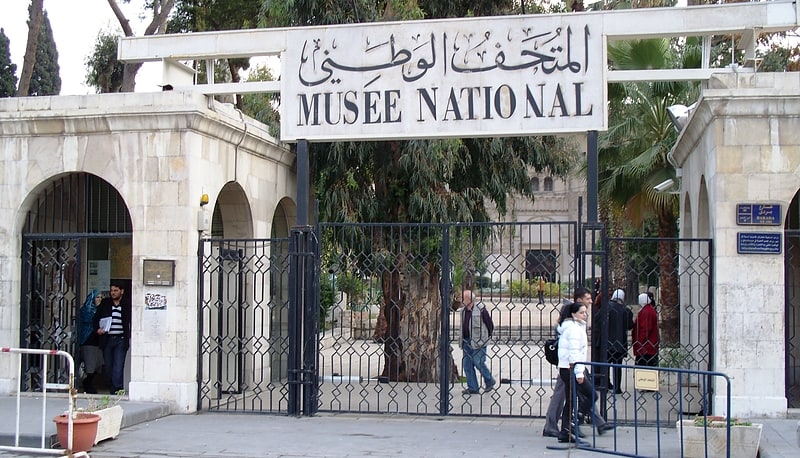
Also known as: المتحف الوطني بدمشق
Museum of Syrian history and art. The National Museum of Damascus is a museum in the heart of Damascus, Syria. As the country's national museum as well as its largest, this museum covers the entire range of Syrian history over a span of over 11 millennia. It displays various important artifacts, relics and major finds most notably from Mari, Ebla and Ugarit, three of Syria's most important ancient archaeological sites. Established in 1919, during King Faisal's Arab Kingdom of Syria, the museum is the oldest cultural heritage institution in Syria.
Among the museum's highlights are, the Dura-Europos synagogue, a reconstructed synagogue dated to 245 AD, which was moved piece by piece to Damascus in the 1930s, and is noted for its vibrant and well preserved wall paintings and frescoes, as well as sculptures and textiles from central Palmyra, and statues of the Greek goddess of victory from southern Syria. The museum houses over 5000 cuneiform tablets, among them the first known alphabet in history, written down on a clay tablet, the Ugaritic alphabet. The museum is further adorned by 2nd-century murals, elaborate tombs, and the recently restored Lion of al-Lat, which originally stood guard at the National Museum of Palmyra, but was moved to Damascus for safeguarding.
The museum temporarily closed its doors in 2012, after the Syrian Civil War engulfed Damascus and threatened its rich cultural artifacts. The museum authorities quickly unloaded more than 300,000 artifacts and hid them in secret locations to safeguard Syria's cultural heritage from destruction and looting. After six years, the museum reopened four of its five wings on October 29, 2018.[1]
Address: Shoukry Al-Qouwatly, Damascus
Umayyad Mosque
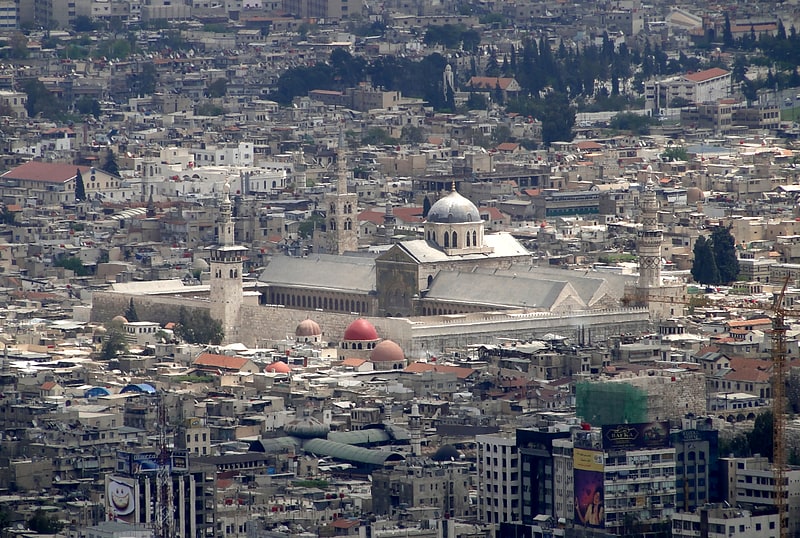
Also known as: الجامع الأموي
Landmark ancient mosque and burial site. The Umayyad Mosque, also known as the Great Mosque of Damascus, located in the old city of Damascus, is one of the largest and oldest mosques in the world. Its religious importance stems from the eschatological reports concerning the mosque, and historic events associated with it. Christian and Muslim tradition alike consider it the burial place of John the Baptist's head, a tradition originating in the 6th century. Muslim tradition holds that the mosque will be the place Jesus will return before the End of Days. Two shrines inside the premises commemorate the Islamic prophet Muhammad's grandson Husayn ibn Ali.
The site has been used as a house of worship since the Iron Age, when the Arameans built on it a temple dedicated to their god of rain, Hadad. Under Roman rule, beginning in 64 CE, it was converted into the center of the imperial cult of Jupiter, the Roman god of rain, becoming one of the largest temples in Syria. When the empire in Syria transitioned to Christian Byzantine rule, Emperor Theodosius I (r. 379–395) transformed it into a cathedral and the seat of the second-highest ranking bishop in the Patriarchate of Antioch.
After the Muslim conquest of Damascus in 634, part of the cathedral was designated as a small prayer house (musalla) for the Muslim conquerors. As the Muslim community grew, the Umayyad caliph al-Walid I (r. 705–715) confiscated the rest of the cathedral for Muslim use, returning to the Christians other properties in the city as compensation. The structure was largely demolished and a grand congregational mosque complex was built in its place. The new structure was built over nine years by thousands of laborers and artisans from across the Islamic and Byzantine empires at considerable expense and was funded by the war booty of Umayyad conquests and taxes on the Arab troops of Damascus. Unlike the simpler mosques of the time, the Umayyad Mosque had a large basilical plan with three parallel aisles and a perpendicular central nave leading from the mosque's entrance to the world's second concave mihrab (prayer niche). The mosque was noted for its rich compositions of marble paneling and its extensive gold mosaics of vegetal motifs, covering some 4,000 square metres (43,000 sq ft), likely the largest in the world.
Under Abbasid rule (750–860), new structures were added, including the Dome of the Treasury and the Minaret of the Bride, while the Mamluks (1260–1516) undertook major restoration efforts and added the Minaret of Qaytbay. The Umayyad Mosque innovated and influenced nascent Islamic architecture, with other major mosque complexes, including the Great Mosque of Cordoba in Spain and the al-Azhar Mosque of Egypt, based on its model. Although the original structure has been altered several times due to fire, war damage and repairs, it is one of the few mosques to maintain the same form and architectural features of its 8th-century construction, as well as its Umayyad character.[2]
Address: Old City, Damascus
Azm Palace
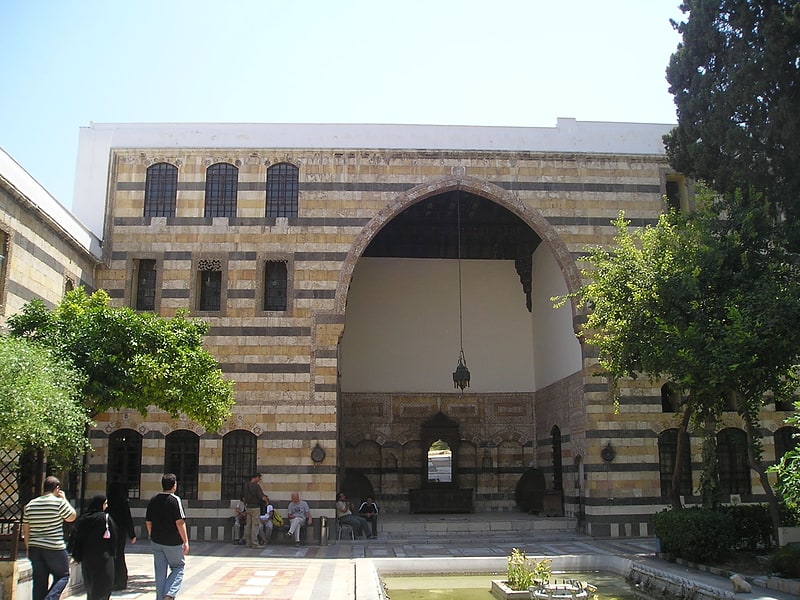
Also known as: قصر العظم
Palace in Damascus, Syria. Azm Palace is a palace in Damascus, Syria which dates back to the 18th century. Located north of Al-Buzuriyah Souq in the Ancient City of Damascus, the palace was built in 1749 and was the private residence for As'ad Pasha al-Azm, the governor of Damascus, and during the French Mandate for Syria and the Lebanon it housed the French Institute.
After being purchased by the Syrian government from the Al-Azm family and undergoing several reconstruction works, the palace now houses the Museum of Arts and Popular Traditions.[3]
Address: Damascus, Al-Buzuriyah Souq
Citadel of Damascus
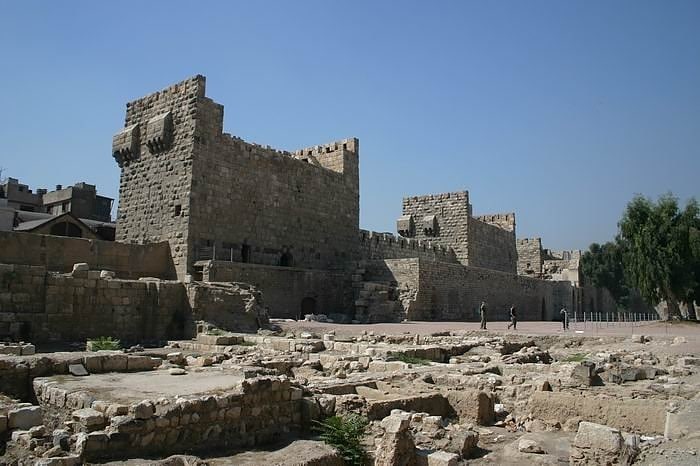
Also known as: قلعة دمشق
Historical landmark in Damascus, Syria. The Citadel of Damascus is a large medieval fortified palace and citadel in Damascus, Syria. It is part of the Ancient City of Damascus, which was listed as a UNESCO World Heritage Site in 1979.
The location of the current citadel was first fortified in 1076 by the Turkman warlord Atsiz bin Uvak, although it is possible but not proven that a citadel stood on this place in the Hellenistic and Roman periods. After the assassination of Atsiz bin Uvak, the project was finished by the Seljuq ruler Tutush I. The emirs of the subsequent Burid and Zengid dynasties carried out modifications and added new structures to it. During this period, the citadel and the city were besieged several times by Crusader and Muslim armies. In 1174, the citadel was captured by Saladin, the Ayyubid sultan of Egypt, who made it his residence and had the defences and residential buildings modified.
Saladin's brother Al-Adil rebuilt the citadel completely between 1203 and 1216 in response to the development of the counterweight trebuchet. After his death, power struggles broke out between the other Ayyubid princes and although Damascus switched hands several times, the citadel was taken by force only once, in 1239. The citadel remained in Ayyubid hands until the Mongols under their general Kitbuqa captured Damascus in 1260, thereby ending Ayyubid rule in Syria. After an unsuccessful revolt broke out in the citadel, the Mongols had most of it dismantled. After the defeat of the Mongols in 1260 by the Mamluks, who had succeeded the Ayyubids as rulers of Egypt, Damascus came under Mamluk rule. Except for brief periods in 1300 and 1401, when the Mongols conquered Damascus, the Mamluks controlled the citadel until 1516. In that year, Syria fell into the hands of the Ottoman Empire. Damascus surrendered without a fight and from the 17th century onward the citadel functioned as barracks for the Jannisaries—Ottoman infantry units. The citadel started to fall into disrepair in the 19th century and its last military use was in 1925, when French soldiers shelled the old city from the citadel in response to the Great Syrian Revolt against the French Mandate of Syria. The citadel continued to serve as a barracks and prison until 1986, when excavations and restorations started. As of 2011, excavation and restoration efforts are still ongoing.
The citadel is located in the northwest corner of the city walls, between the Bab al-Faradis and the Bab al-Jabiyah. The citadel consists of a more or less rectangular curtain wall enclosing an area of 230 by 150 metres (750 by 490 ft). The walls were originally protected by 14 massive towers, but today only 12 remain. The citadel has gates on its northern, western and eastern flanks. The current citadel dates primarily to the Ayyubid period while incorporating parts of the older Seljuq fortress. Extensive repairs in response to sieges and earthquakes were carried out in the Mamluk and Ottoman periods.[4]
Maktab Anbar

Also known as: مكتب عنبر
Building in Damascus, Syria. Maktab Anbar is a house in the center of Old Damascus, Syria. The house was built as a private residence by a local Jewish notable Mr. Anbar in the mid 19th century and was later confiscated by the Ottoman government after Mr. Anbar's bankruptcy.
The house is built around three courtyards, first the formal reception courtyard, behind this the attractive female courtyard, and finally the spartan servants' courtyard. Due to the cost of building, the owner turned the building into the Damascus Civil Preparatory School, which was a prestigious, expensive, tuition-based school for the children of the land-owning families of Damascus. According to Philip Khoury, many Syrian nationalist leaders who worked and were co-opted by the French from 1928 and independence in 1946, were graduates of Maktab Anbar. The house was restored by the Ministry of Culture in 1976. It now holds a library exhibition hall, museum and craft workshops.[5]
Mausoleum of Saladin

Also known as: ضريح صلاح الدين الأيوبي
Ancient burial site of a medieval ruler. The Mausoleum of Saladin holds the resting place and grave of the medieval Muslim Ayyubid Sultan Saladin. It is adjacent to the Umayyad Mosque in Damascus, Syria. It was built in 1196, three years after the death of Saladin. Originally the tomb complex included the burial of Salah al-Din and Madrassah al-Aziziah of which little remains except a few columns and an internal arch adjacent to the renovated tomb of Saladin.
The mausoleum presently houses two sarcophagi: one made of wood, said to contain Saladin's remains, and one made of marble, was built in homage to Saladin in late nineteenth century by Ottoman Sultan Abdulhamid II and was later restored by German emperor Wilhelm II. Along with a marble sarcophagus, a golden ornate gilt bronze wreath was also put on the marble sarcophagus, which was later removed by either Faisal I or Lawrence of Arabia who later deposited it in the Imperial War Museum.[6]
Address: Old Town, Omayyad Mosque, Damascus
Syriac Catholic Cathedral of Saint Paul
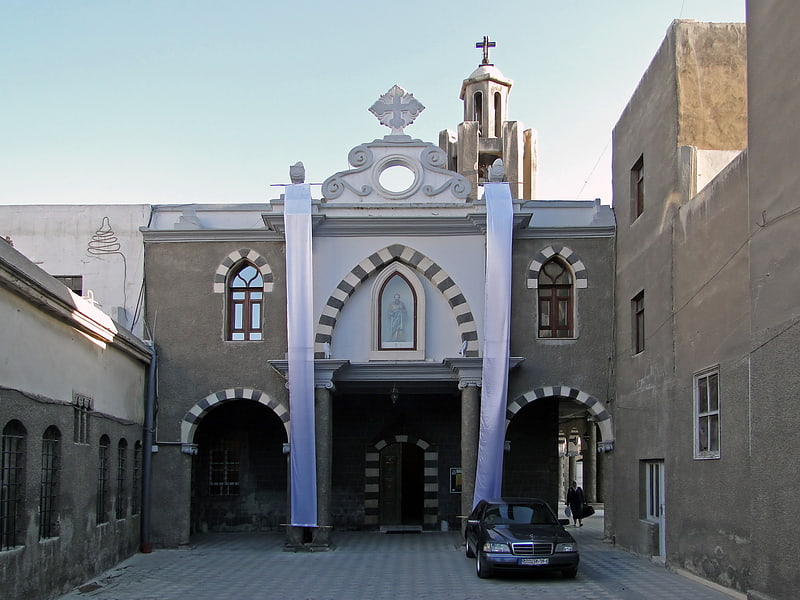
Syriac Catholic Cathedral of Saint Paul is the cathedral of the Syriac Catholic Church, located in Damascus, Syria. It is the see of the Syriac Catholic Archeparchy of Damascus and is located in the Christian quarter of Damascus, 100 m west of Bab Sharqi.[7]
Sayyidah Zaynab Mosque
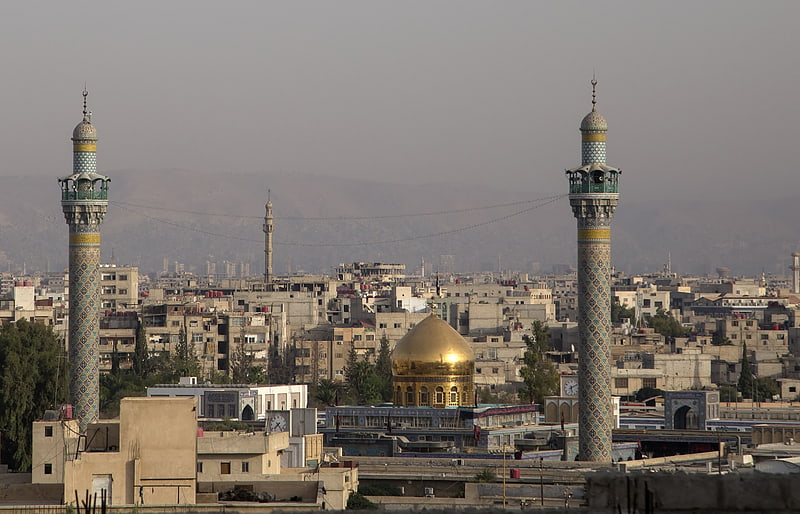
Also known as: مقام السيدة زينب في الشام
Mosque in Sayyidah Zaynab, Syria. Sayyidah Zaynab Mosque is a mosque located in the city of Sayyidah Zaynab, in the southern suburbs of Damascus, Syria. According to Twelver Shia Muslim tradition, the mosque contains the grave of Zaynab, the daughter of ‘Alī and Fātimah and granddaughter of Muhammad. Ismaili Shia tradition place Zaynab's tomb in the mosque of the same name in Cairo, Egypt. The tomb became a centre of Twelver religious studies in Syria and a destination of mass pilgrimage by Twelver Shia Muslims from across the Muslim world, beginning in the 1980s. The zenith of visitation normally occurs in the summer. The present-day mosque that hosts the tomb was built in 1990.[8]
Tekkiye Mosque

Also known as: التكية السليمانية
Mosque in Damascus, Syria. The Tekkiye Mosque or Sultan Selim Mosque is a mosque complex in Damascus, Syria, located on the banks of the Barada River.[9]
Saint Anania's House
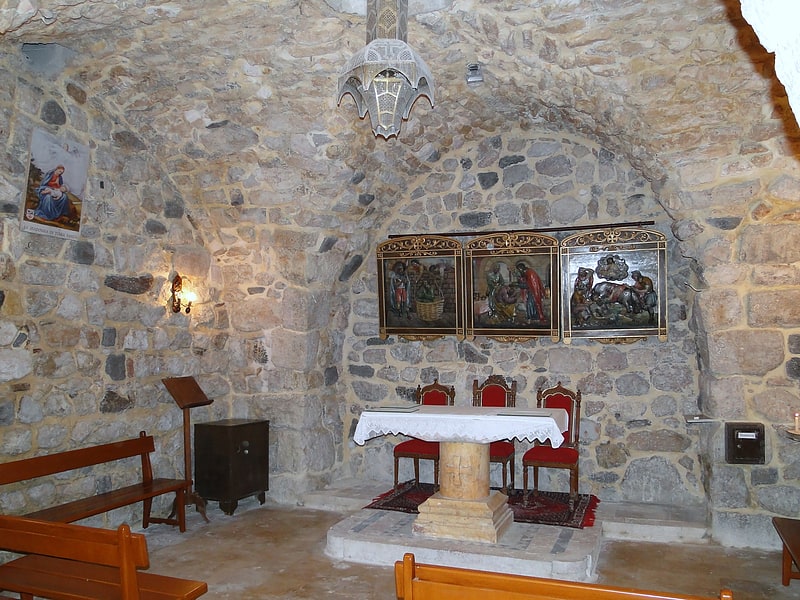
Also known as: كنيسة حنانيا
Building. The House of Saint Ananias is an ancient underground structure in Damascus, Syria, that is said to be the remains of the home of Ananias of Damascus, where Ananias baptized Saul. The building is at the end of the Street Called Straight near the Bab Sharqi. As of 2010, the structure was still in use as a church.[10]
Mariamite Cathedral of Damascus
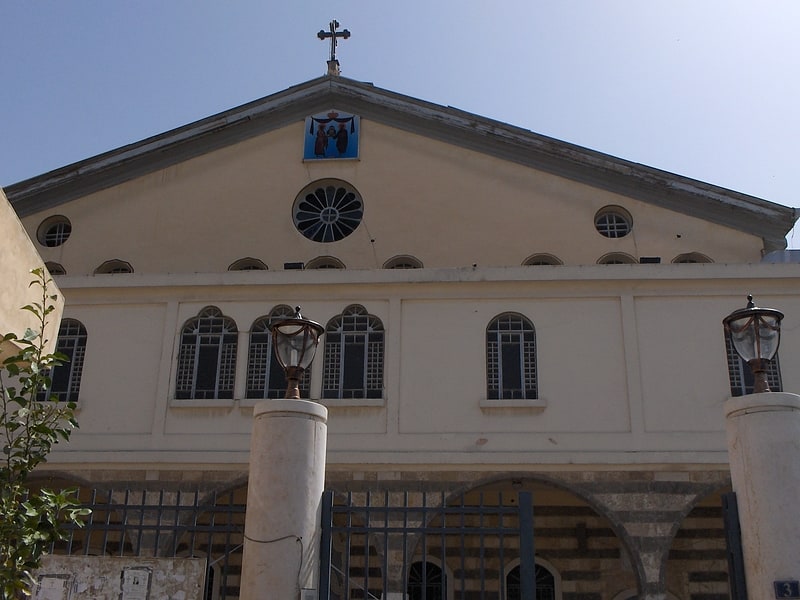
Also known as: الكنيسة المريمية
Christian church in Damascus, Syria. The Mariamite Cathedral of Damascus, also known as the Maryamiyya Church, is one of the oldest Greek Orthodox churches in Damascus, Syria and holds the seat of the Greek Orthodox Church of Antioch. The church complex is located on the Street Called Straight.[11]
Marjeh Square
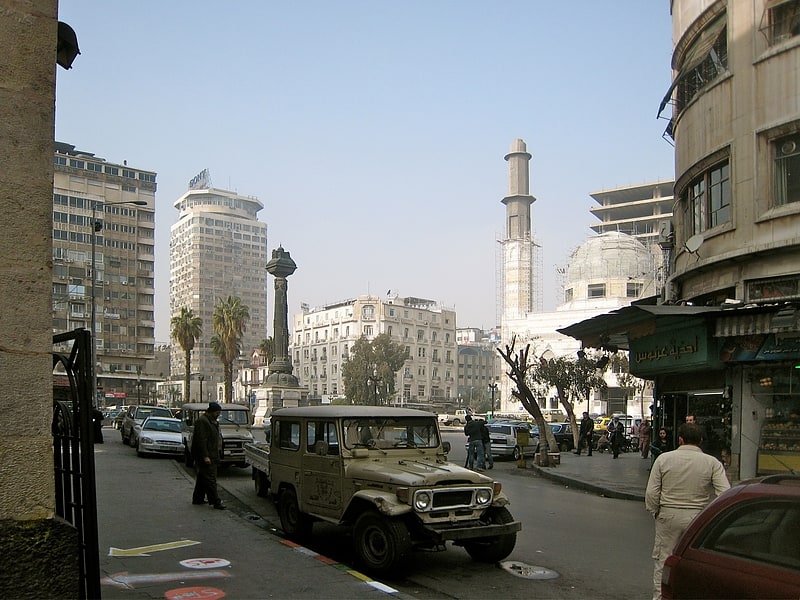
Also known as: ساحة المرجة
Marjeh Square, also known as "Martyrs' Square", is a square in central Damascus, Syria, just outside the walls of the old city. The Syrian Interior Ministry has its headquarters in the square.[12]
Sinan Pasha Mosque
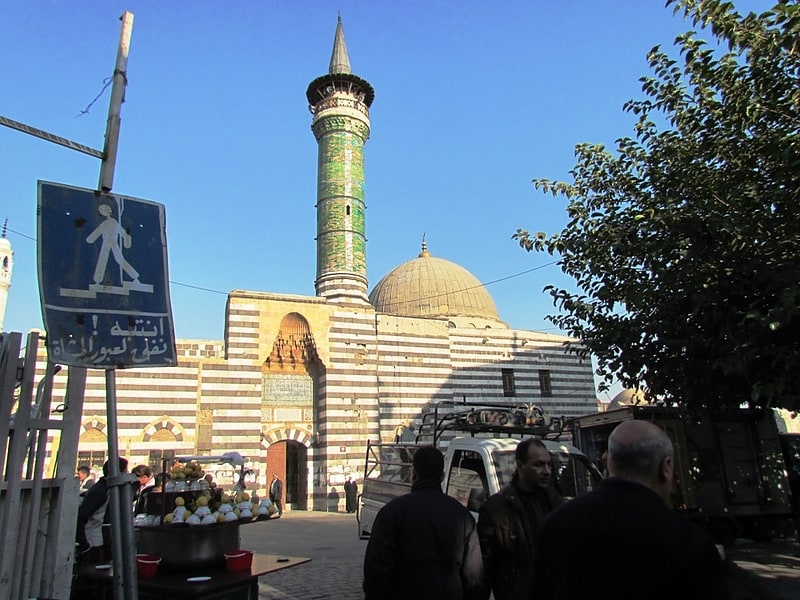
Also known as: جامع سنان باشا
Mosque in Damascus, Syria. The Sinan Pasha Mosque is an early Ottoman-era mosque in Damascus, Syria, located along Suq Sinaniyya Street.[13]
Cathedral of the Dormition of Our Lady
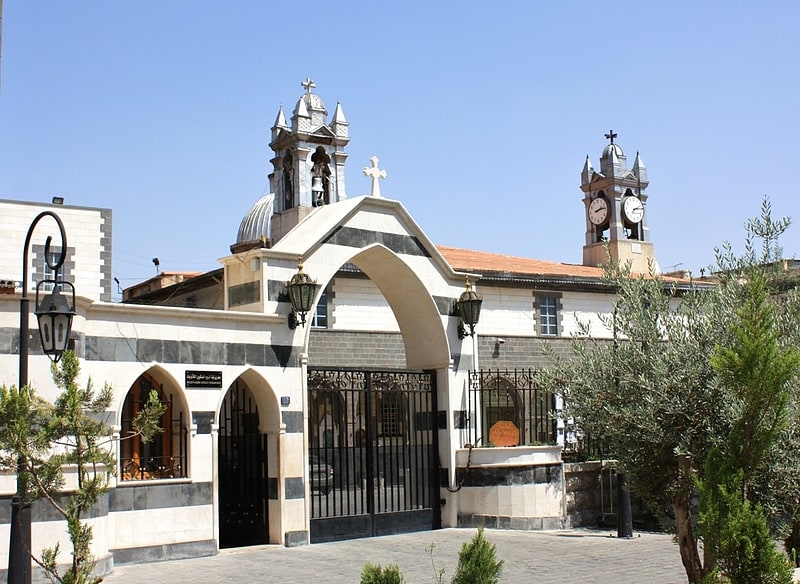
Also known as: كاتدرائية سيدة النياح
Cathedral in Damascus, Syria. The Cathedral of Our Lady of the Dormition, also called the Melkite Greek Catholic Patriarchal Cathedral of the Dormition of Our Lady, is the cathedral of the Melkite Greek Catholic Church in the city of Damascus, Syria. It is the seat of the Greek-Melkite Archeparchy of Damascus dependent on the Melkite Catholic Patriarchate of Antioch, which includes about 150,000 baptized adherents and twenty parishes with fifty priests. Its faithful, assigned from the 18th century to the Holy See in Rome, employ the Arabic language and the Byzantine rite.
The Archbishop Vicar (or Eparca) starting in 2006 was Youssef Absi, former Superior General of the Society of Missionaries of St. Paul. On June 21, 2017, he was elected as the Melkite Greek Patriarch.
The cathedral is dedicated to the Dormition of the Virgin, the Eastern Christian "counterpart" to the Latin Church doctrine of the assumption of Mary.[14]
Cinema City
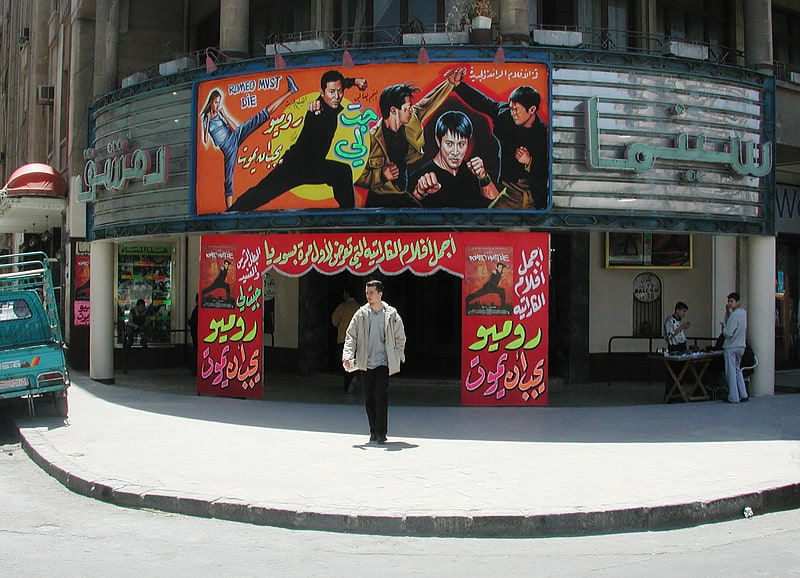
Theater. Cinema Dimashq is a movie theater in Damascus, Syria. The theater was one of the largest single room cinemas in the Arab World, with a total seating capacity of 1500, the ground floor seated 1000 moviegoers and a large balcony seated 500. It is currently the only cinema in Syria featuring the latest American and European productions. The movie theater currently features 4 medium-sized projection rooms of about 300 places each.
Opened in 1943 by Toufik Chammas, a prominent local businessman, Cinema Dimashq rapidly became a local entertainment proxy, bringing Syria into the era of cinematography.
Closed in early 2005, and reopened in mid-2009, its current name is Cinema City.
Completely renovated, the cinema now features a sushi bar, and digital projectors.
Cinema City did come under criticism as it was later accused of evading US sanctions imposed onto Syria since 2003, and projecting US movies the same day they would debut in Dubai, Lebanon and other prevalent West Asian and North African cities.[15]
Address: Damascus, Damascus
Damascus Opera House
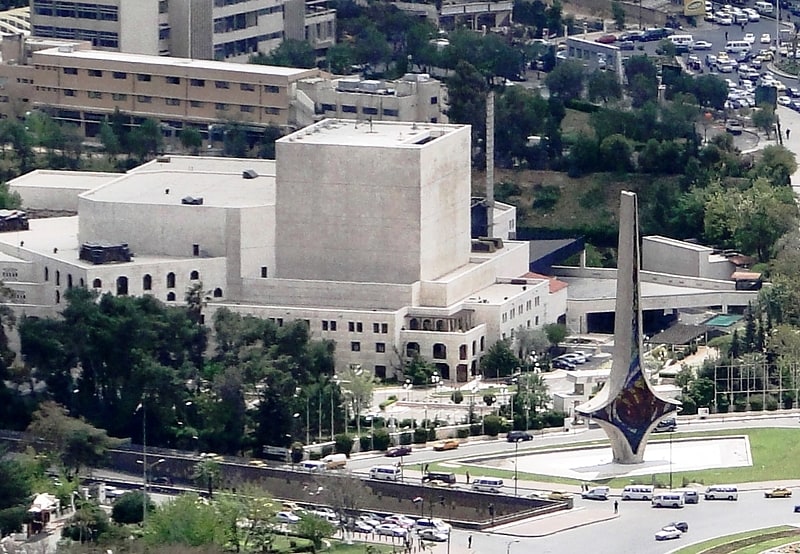
Also known as: دار الأسد للثقافة والفنون
Live music venue in Damascus, Syria. The Damascus Opera House is the national opera house of Syria. Inaugurated on 7 May 2004, it is located in central Damascus, on the Umayyad Square.[16]
Bab al-Saghir
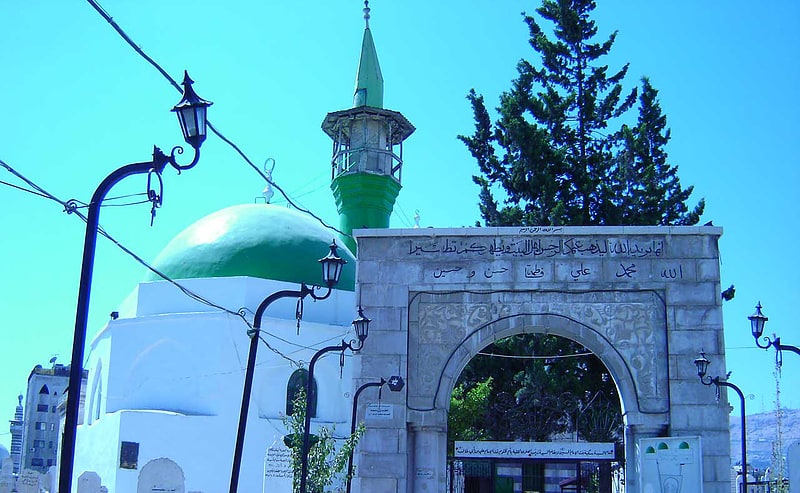
Also known as: باب الصغير
Cemetery in Damascus, Syria. Bāb aṣ-Ṣaghīr, also called Goristan-e-Ghariban, may refer to one of the seven gates in the Old City of Damascus, and street in the modern city of Damascus, Syria. It has qubûr on either side of the road, and is located in the Dimashq Neighborhood, southwest of the Umayyad Mosque.[17]
St Paul
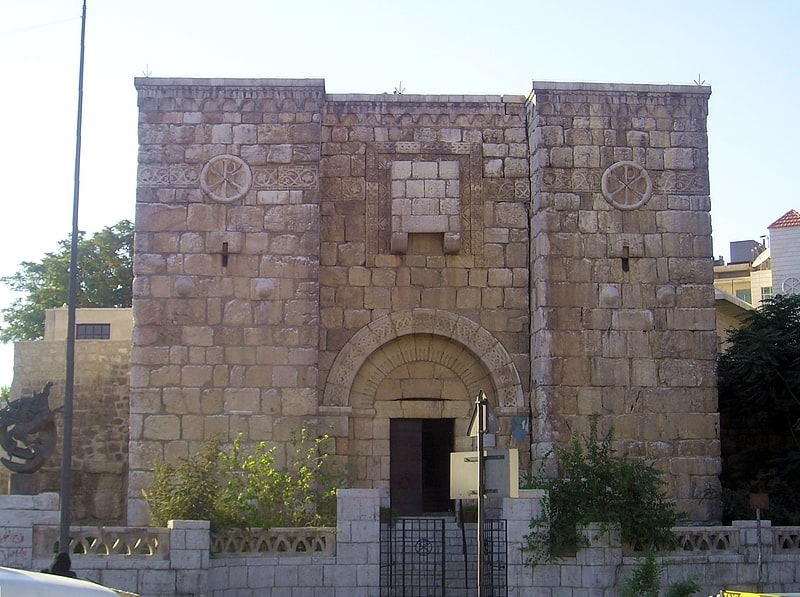
The Chapel of Saint Paul is a church in Damascus, Syria, located along Tarafa bin al-Abd Street near the former Bab Kisan.
The chapel, consecrated in 1939, includes some stones from the Bab Kisan, which is believed to be the site of St Paul's escape from Damascus by being lowered out of a window in a basket.[18]
Sabaa Bahrat Square
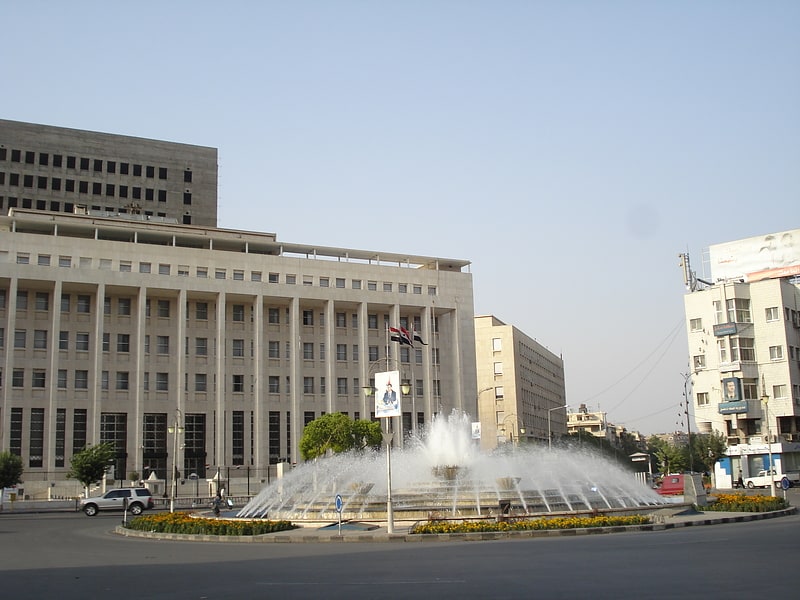
Also known as: ساحة السبع بحرات
Sabaa Bahrat Square is a large and important square in Damascus, Syria. Many important official buildings and ministries are located in the area including the Central Bank of Syria. Many important streets branch from there including Baghdad Street.
It was first erected by French mandate authorities in 1925 in memory of a French captain called Gaston Descarpentries. The square had a small dome with seven fountains, and was called "Captain Decarpentry Square.In 1938 Baira's mosque was built by Rashid Baira." After the independence of Syria the authorities removed the monument and renamed the square. During the Syrian civil war against the government of President Bashar al-Assad machine-gun fire was reported in nearby Sabaa in the square, which was the scene of several major pro-government demonstrations.[19]
Cathedral of Saint George
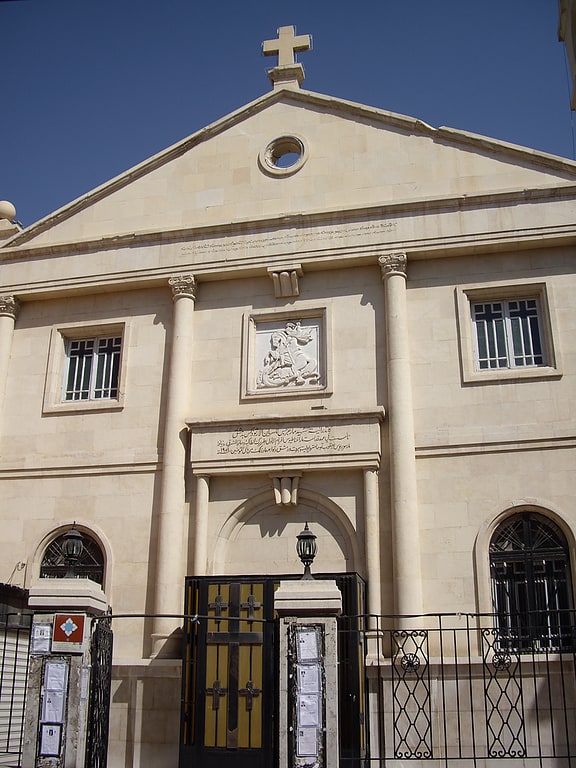
Cathedral. The Cathedral of Saint George is a Syriac Orthodox cathedral located in Bab Tuma, central Damascus, Syria. It is the headquarters of the Syriac Orthodox Eparchy of Damascus, of Patriarch Ignatius Aphrem II of Antioch; acting as the seat of the Syriac Orthodox Church since 1959.[20]